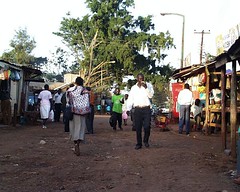control

And then, there's this commentary from Jeb Brugmann in yesterday's Globe and Mail.
"The recent violence in Kenya is part of an increasingly chronic condition in a world that is cramming — without effective urban investment, planning and management — into its cities," so says Brugmann. I agree, but then Brugmann goes on:
From Nairobi to Paris, Guangzhou to La Paz, riots and political upheaval have been fuelled by a failure to manage the gold rush-like claims of hundreds of millions of rural, poor people upon the economic opportunities of cities. Though not commonly understood as such, mismanaged urban migrations have been a central part of political revolutions in our world since the 1960s.The demographic of the young, urban poor and jobless can contribute to civil instability, no argument there. But then Brugmann continues:
This trend began with the American rebellion of black urban migrants from the rural South that gave them political control of U.S. cities in the 1970s and '80s. It has since included the 1979 revolution in Iran, the 1986 "People Power" movement in the Philippines, the 1994 end of apartheid in South Africa, recent gains by Islamic political forces throughout the Middle East, and the "Bolivarian Revolution" of Hugo Chavez in Venezuela in 2000. In each instance, new political power has been discovered and organized in the slums and ghettos of urban migrants.1986? People-power? Driven by "uncontrolled" urban migration (e.g. -the urban poor)? Really? Brugmann has to go back to his research. 1986 was driven mostly by the middle-class.
You might argue that EDSA-Tres, 2001, could be attributable to the crush of rural-to-urban migration, but not 1986.
But my big question to Mr. Brugman -or to anyone else who argues that "uncontrolled rural to urban migration" is the problem is: can you please point to any example of a "well-managed" rural-to-urban migration?
Anyone? Anyone?
Image credit: Kibera Life!
by rogiro
by rogiro

1 comment:
"Brugmann" here clarifying the author's (mis)interpretation of my 2008 op-ed piece. First, 1986: many small groups of largely middle class people obviously mobilized the movement, but many more than the middle class participated in the streets at the mobilization's heights. Only 11% of Metro Manila's 7 million population was middle class in 1985-86--less than a million people. The entire middle class of the Philippines was fewer than the 1-3 million person estimates at the largest EDSA demonstration. Support from the swelling, in-migrating working class and informal sector was critical to the tipping point.
2. "well managed". the point is not whether there are excellent cases. In fact, my point is that we have failed in this regard. However, pathways from village to urban life can be created that provide steady entry of rural poor into formal sector political and economic enfranchisement in the cities. That is the point. We need to get on with putting these pathways in place.
Post a Comment